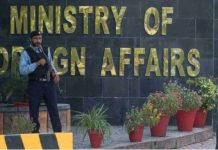Dr. Mehmood Ul Hassan Khan
Indonesia is one the “hottest” destinations for regional as well as international tourists in the world. It has “beautiful” landscape, rich cultural diversity, unique “bio-diversity”, eco-friendly environment, lavish hospitality and holistic policies to “mesmerize” the world. Moreover, it has perfect “resources” and national “drive” to make it one of the most “spectacular” tourist destinations on earth.
Right from the beginning, President Joko Widodo emphasized that the tourism industry should become the biggest industry in Indonesia in terms of foreign exchange earnings. Indonesia is a huge “Archipelago” that consists of more than 17000 islands. It has magic, pleasant surprises, amazing history, traditions, and customs which have so much to offer to foreign tourists. It has beautiful beaches and countryside, flora & fauna, diving spots, wildlife, culture, culinary, historic relics as well as vibrant city life.
Indonesia was ranked “20th” in the world tourist Industry in 2017. The country was declared the “9th” fastest growing tourist destination in the world. It ranked as the “3rd” fastest growing in Asia and fastest-growing in Southeast Asia. During 2019 the “Lonely Planet” ranked Indonesia as one to the top 10 countries to visit in 2019.
Tourism is indeed one of the main sectors of Indonesian macro-economy. It is one of the leading sources of its foreign exchange revenues. It planned to achieve 8 per cent of GDP from the tourism sector and targeted to attract about 20 million visitors by 2019. The tourism sector ranked as the 4th largest among goods and services export sectors.
The government of Indonesia initiated a “multi-functional” and “multi-sectoral” integrated “branding campaign” which has now further enhanced strategic importance, utility, scope and productivity of the tourism sector. It has actually, boosted the economy and generated plenty of new jobs.
For the further development of tourism sector and attraction of more and more regional as well as international tourists the Indonesian government has given priority to 10 destinations such as Borobudur, Central Java; Mandalika, West Nusa Tenggara; Labuan Bajo, East Nusa Tenggara; Bromo-Tengger-Semeru, East Java; Thousand Islands, Jakarta; Toba, North Sumatra; Wakatobi, Southeast Sulawesi; Tanjung Lesung, Banten; Morotai, North Maluku; and Tanjung Kelayang, Belitung, and planned to assign maximum supplies for the said destinations.
Indonesia is blessed with some of the most beautiful and unexplored islands in the world. Most of these islands have pure nature, colors, flowers, clean waters, confortable sands, and peaceful shelters. These islands have now become ideal destination for adventure, nature exploration, family reunion, newly married couples excitement hub, and forests livings. Proper infrastructural development may be a “value-addition” for the further development of tourism sector in Indonesia. Proper “watering system” may be giant step towards achieving the desired goals in tourism sector.
Energy is life and key to robust development. Easy and smooth supplies of energy (electricity) may be gearing point for the further development of tourism sector in the country especially in remote locations. Green energies, micro-grids may be an attractive option for many remote locations of Indonesia.
The government of Indonesia should take extra care about “geology” and “climate” for the development of tourism in the country. Moreover, a public-private partnership (PPP) orientation especially the high inflows of the FDIs may “revolutionize” its efforts of attracting more and more international tourists. There is an urgent need to remove all ambiguities in legal framework for projects, and procurement processes.
Prior to the COVID-19 outbreak, Indonesia had outlined a target to receive at least 17 million foreign tourists in 2020. According to the Central Statistics Office (BPS) 2020 the number of foreign tourists visiting Indonesia had dropped sharply to 470,900, or equal to the figure in 2007.
Tourism industry activities continued normally in January 2020, though a decline was recorded. In comparison with the January-March 2019 period, the number of tourist arrivals registered a decrease of 30.62 percent in the first quarter of this year.
Bali, one of the world’s most famous resort islands, has also suffered a major blow. Currently, Bali receives some 500 tourists daily, while normally, the number of foreign tourist arrivals was pegged between 10,500 and 11,000 per day. Most of the travelers were Australians. However, Indonesian minister is upbeat about the sector’s projected gradual recovery in June and expediting in 2021.
He believed the current pressures on the tourism and creative economy owing to the pandemic have, in fact, driven operators to learn strategies to make the industry more sustainable in future. President Joko Widodo shared a similar viewpoint and believes that the pressure on the tourism and creative economy sectors from the COVID-19 pandemic will allay by year-end, and a rebound is projected in 2021.
It is expected that halal tourism has great potential in the future and Indonesia has the perfect ‘internal make-up’ to become a great destination in terms of halal tourism.
Tourism in Indonesia has more than doubled over the past decade. The tourism industry has flourished and become a major driver of the economy and a central feature of the government’s economic growth strategy. To facilitate further growth, the Indonesian Government is hoping to replicate the success of Bali as a tourist destination in a number of other locations spread across Indonesia.
The tourism industry is a major economic driver for Indonesia. In 2016, foreign exchange earnings from tourism totalled $16.3 billion. When indirect and induced incomes from travel and tourism are included such as investment spending and spending by employees), that figure increases to $72.4 billion, or approximately 6.2 per cent of GDP in 2016.
According to the World Travel & Tourism Council report (2020) strong growth is expected for the Indonesian industry, with indirect and induced incomes predicted to reach $141.3 billion annually by 2027.
The project “New Bali” was announced in 2016 to develop ten new tourist hubs across the country. Attracting visitors to other areas will be essential to plans aimed at expanding the Indonesian tourism industry. According to the Ministry of Tourism, the tourist destinations chosen for development are already known as tourist attractions, but would greatly benefit from better access and more amenities.
One of the locations selected, Lake Toba, is a good example. Lake Toba is well known among tourists travelling to Indonesia, but has lacked easy access. Before a new international airport was built in Silangit, to get to Parapat near Lake Toba, most tourists had to catch a domestic flight to Medan (over two hours from Jakarta), then head to the lake via bus or car, which took another four to six hours. With the new airport, however, travel times will be reduced to only two hours. That will significantly increase the prospects for tourism in the Lake Toba area. The government hopes to see the first international flights to the new airport sometime this year.
In developing those locations, the government hopes to expand tourism as an economic behemoth, without devaluing existing tourist destinations. It is highly unlikely that Indonesia could accommodate twenty million tourists in 2019 without diverting some of those tourists to locations other than Bali. That would have the added benefit of creating local jobs in the new tourist areas.
It is advisable that promotion of halal tourism should not be confined to Middle Eastern countries alone. South Asian countries, such as India, Pakistan and Bangladesh, are all in relatively close proximity to Indonesia. In 2016, approximately 500,000 tourists from the South Asian region visited Indonesia.
In many international rankings such as the Most Beautiful Countries in the World Index or the Global Muslim Travel Index Indonesia is ranked highly. Indonesia is a “mesmerizing” country which is located between the Indian and the Pacific Ocean. It is the largest island country, covering an area of 1.905 million kilometers. It is a majestic land which is blessed with diverse landscapes. From its pristine beaches to smoldering volcanoes and verdant jungles, Indonesia has something for everyone. It has unlimited natural magic with magnificent locations too.
Jakarta the capital city is the hub of beauty and bliss. From the Grand Indonesian Mall for shopping lovers, to the Istiqual Mosque and the Jakarta Cathedral shrouded in a mystical aura, to the vibrant National Museum, the elegant old town of Jakarta to the glistering China Town, it has much to allure the tourists. It has sandy thousand Islands, the beautiful Miniature Park and thrilling rides at Waterbom Jakarta for satisfying the international tourists.
It has some other gorgeous attractions like Lake Toba on Sumatra Island which is a magnanimous volcanic lake that was formed by a huge volcanic eruption 70,000 years ago. Apart from its natural beauty, the lake is also a prefect spot to relax, unwind and swim in the volcanically warm waters.
Moreover, the Tanjung Puting National Park on Borneo Island is a paradise for animal lovers, the park features boat rides to explore its diverse flora and fauna. The Baliem Valley in Western New Guinea is an ideal destination for adventure. It is the home to the Dani Tribe, blessed with nature’s bounty rolling mountains and the mighty rivers.
Mount Bromo an active volcano, is an interesting tourist attraction. Its inner crater produces white smoke and it is therefore surrounded by a sea of volcanic sand. For adventure enthusiasts, Bunaken on the island of Sulawesi is famous for diving and snorkeling activities. The beautiful sun bathed islands of Gili are an exotic destination to completely untwine.
The Indonesian government has prepared a post-pandemic economic recovery scenario for the manufacturing industry, tourism, and investment sectors.
It has started mega infrastructure development, the visa-free visit entry for many nations, and specifically the “Ten New Balis” program to attract more and more international tourists.
It introduced the “Ten New Balis” program which has four new “Super Priority Destinations”, namely: Toba Lake (North Sumatra), Borobudur (Central Java), Mandalika (Flores), and Labuan Bajo (Flores).
The post COVID needs a new comprehensive policy. Keep wearing masks, keep physical distance, wash hands, and the government’s new policy, which requires visitors to show a non-reactive letter from rapid test or PCR.
Being prominent regional geopolitical expert I am optimistic about Indonesian tourism industry recovery following the mass vaccination. I forecast that Borobudur Temple would become the most visited destination in post COVID era. It has become a great magnet attracting visitors from other countries to visit one of the World’s Wonders. Toba Lake, Mandalika, and Labuan Bajo also have a good prospect of tourism visitation in 2021. Mandalika has also become a great magnet because it will become a MotoGP circuit which is at the global level. With this circuit, more visitors will allocate their time and potential to visit Mandalika.
Indonesian has great tourism industry. For the further development of it there is an urgent need to start “structural reforms” in this vital sector of macro-economy including, start-up of halal tourism, infrastructural development, easy and smooth supplies of water & electricity, FDIs, and last but not least, ideal combination of public-private partnership.











